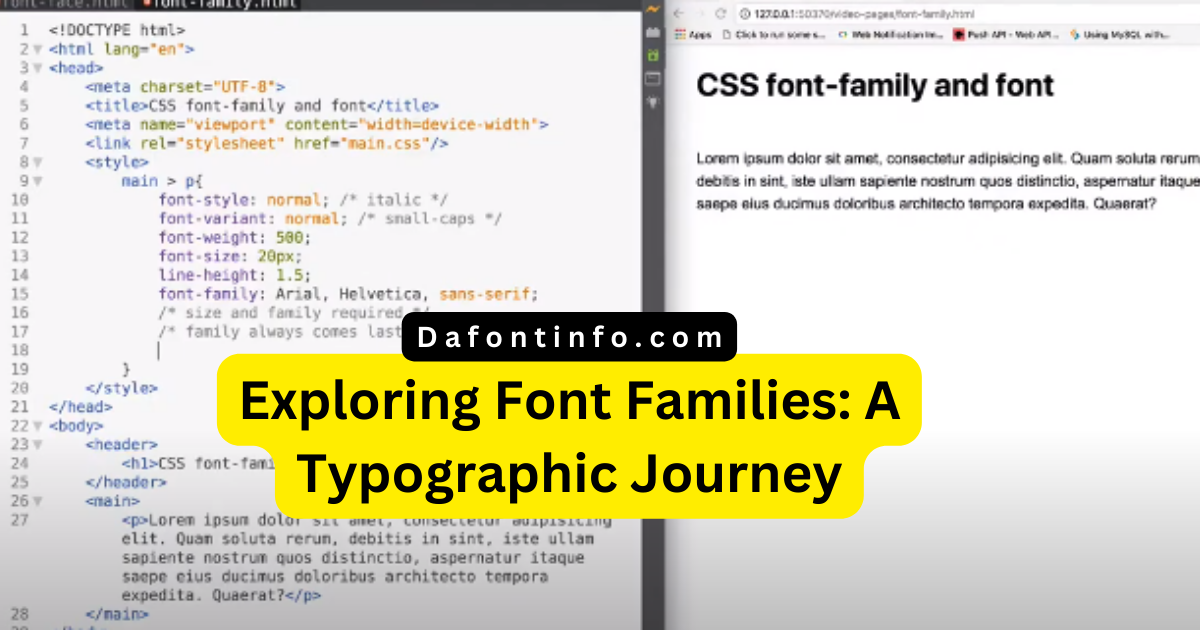Demystifying Font Families: Grasping Serif and Sans-Serif Fonts
The foundation of typography is font families, which have an impact on how text appears and is understood. They can be divided into five main categories: fantasy, monospace, cursive, sans-serif, and serif. Serif and sans-serif fonts are two important members of the font family that will receive the majority of our attention in this essay. These typefaces have unique characteristics that significantly affect how text appears and the meaning it delivers.
The Basics of Font Families
Families of fonts are groups of fonts with similar letter shapes and other visual characteristics. Each subcategory of a font family gives your text a different look.
- Serif Fonts: The tiny strokes or serifs at the extremities of each letter help you identify serif fonts. These serifs give off a formal, elegant vibe. To improve readability and text flow, they are frequently employed in printed publications including books, newspapers, and periodicals. Serif fonts include Times New Roman, Garamond, and Baskerville as illustrations.
- Sans-Serif Fonts: In contrast, sans-serif fonts have simple, unadorned lines that lack any decorative strokes or accents. This uncluttered, uncluttered aesthetic has a contemporary, uncomplicated appeal. Sans-serif typefaces are frequently used for websites, apps, and logos in digital media. On screens, they give a clean and streamlined appearance. Sans-serif fonts include Arial, Helvetica, and Verdana as examples.
Key Differences
The presence or absence of serifs—those tiny lines or strokes—is the main contrast between serif and sans-serif typefaces. Here is a more thorough contrast:
Serif Fonts
- Serif typefaces are regarded as historic and elegant, and they give off a refined vibe.
- Formal aspect: Each letter has a formal aspect due to the serifs on it, making it appropriate for professional papers.
- Print media: Because they improve word flow and readability, they are frequently preferred for printed publications.
Sans-Serif Fonts
- Sans-serif fonts are thought of as modern and minimalistic, delivering a clear and uncomplicated appearance.
- Casual and Informal: Because they don’t have serifs, they appear more informal and casual, which makes them perfect for digital media.
- They are frequently utilized in digital media because displays show them as crisper and cleaner.
Choosing the Right Font
Consider your project’s goals and context while choosing between serif and sans-serif fonts. Serif fonts like Times New Roman or Garamond can be your choice if you’re working on printed products that call for a touch of refinement. Choose sans-serif fonts like Arial or Helvetica for a contemporary and uncluttered appearance in digital media.
Keep in mind that the font family you choose has a big impact on the overall look and readability of your text. To make sure that your message reaches your audience efficiently and visually appeals to them, you must make sensible decisions.
You can use CSS’s font-family attribute to incorporate these fonts into your website design. In the event that a user’s browser is not compatible with the particular font you desire, make sure to give at least one generic family name as a backup choice. By doing this, you can be certain that your content will look good and be readable on any device or platform.
Explore tools like Google Fonts or W3Schools for a large selection of fonts and more information about font families. Additionally, MDN Web Docs has extensive information on the font-family attribute. With this information in hand, you may confidently use fonts to improve your design and communication efforts.
FAQ
What Are Font Families?
Families of fonts are collections of fonts with similar letter styles and other design elements. They let authors and designers select typefaces that are most appropriate for the goals and aesthetics of their projects.
How Are Font Families Classified?
Serif, sans-serif, monospace, cursive, and fantasy are the five generic categories used to classify font families. To meet a range of design and content requirements, each category offers a distinctive appearance and feel.
What Are Serif Fonts?
Serif typefaces are distinguished by the little strokes or serifs that finish each letter. They are frequently employed in printed goods like books, newspapers, and magazines to increase readability because they emanate formality and elegance. Serif fonts include Times New Roman, Garamond, and Baskerville as illustrations.
What Are Sans-Serif Fonts?
Sans-serif typefaces are devoid of serifs or ornamental strokes. They have a clear, contemporary, and minimalistic look that makes them appropriate for digital media including websites, apps, and logos. Arial, Helvetica, and Verdana are a few common sans-serif typefaces.
When Are Monospace Fonts Used?
Fixed-width letters in monospace typefaces make them perfect for displaying code or data. They keep the character spacing constant and guarantee alignment. Using monospace fonts is frequent in data-driven and coding situations.
What Defines Cursive Fonts?
Cursive typefaces make writing more unique and creative by simulating flowing, handmade characters. These fonts are frequently picked for artistic or decorative projects like invitations, cards, or artwork.
What Characterizes Fantasy Fonts?
Fantasy fonts have ornamental and distinctive letter patterns that give text a whimsical or creative feel. They are ideal for tasks that call for a distinctive and eye-catching appearance, such as posters, fantasy books, or artistic exhibits.
How Can I Use Font Families in Web Design?
Using the CSS font-family property, you can specify font families for elements in web design. You can specify one or more preferred fonts with a generic family name as a backup alternative using this attribute. For instance, “font-family: ‘Times New Roman’, serif;” designates serif as the generic substitute and Times New Roman as the preferred font. This makes sure that even if a user’s browser doesn’t support your particular font, your text will still be readable.
Where Can I Find Fonts and Learn More?
Visit services like Google Fonts, which provides a vast selection of web fonts for free, to discover and access different font families. In addition, W3Schools offers beneficial guides and tutorials on web development, including information on CSS and font-family properties. You can consult MDN Web Docs, which provides thorough insights into CSS and web design, for more in-depth knowledge.






